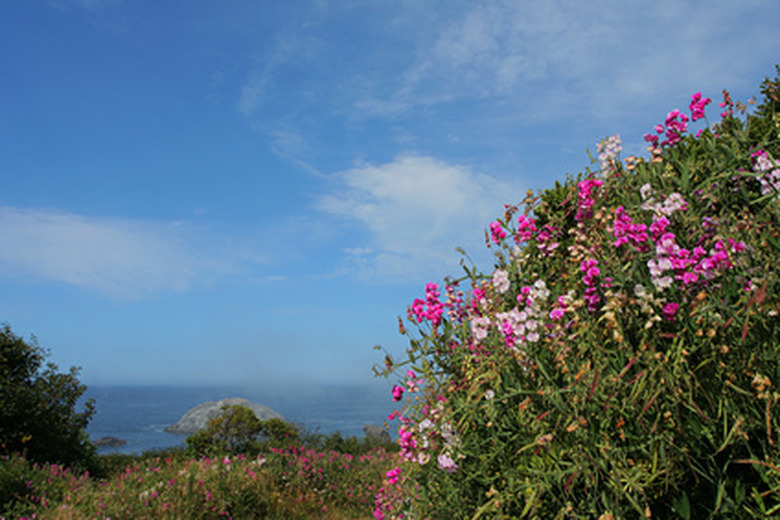Wild Sweet Pea Plant Identification
The wild sweet pea vine (Lathyrus latifolius) grows to a height of 7 feet. Small racemes of pink flowers appear on the vine from spring to fall and are followed by seed pods. Native to central and southern Europe, the plant has also spread to North Africa. The sweet pea has value as a cut flower and an ornamental. In Japan, the flowers are often used in commercial floral arrangements. It has invasive characteristics and has escaped cultivation across the U.S. where it flourishes along road sides and in meadows.
Foliage Appearance
The sweet pea, a herbaceous perennial, sports lance-shaped foliage that flank the stems and petioles. The foliage gives the plant a winged appearance as it grows upwards in a twining habit. Each lance shaped leaf measures up to 3 1/2 inches in length, according to the University of Michigan. The leaves are a light green and smooth. Midway on each leaf a coil threadlike structure is produced which the plant uses to twine and climb upwards. If the plant has nothing to climb on then it spreads outward on the ground in a crawling fashion.
- The wild sweet pea vine (Lathyrus latifolius) grows to a height of 7 feet.
- The sweet pea, a herbaceous perennial, sports lance-shaped foliage that flank the stems and petioles.
Flowers
The plant produces racemes of 4 to 14 flowers on the top of each stem. The flowers appear either pink with a purplish hue or white in color. Each flower measures up to 1 inch across. As the flower ages its color fades dramatically. The flowers hold no scent. The plant blooms over a two month period in midsummer. The flower shape is often compared to that of a small butterfly. The petals are arranged with one large banner petal. Below the banner petal are two tiny petals. The flowers are pollinated by bumble bees.
- The plant produces racemes of 4 to 14 flowers on the top of each stem.
- The flowers appear either pink with a purplish hue or white in color.
Seed Pods
Seed pods appear following flowering. Each seed is a light green in color with no hair. The seed pod is flat and measures approximately 2 inches in length and 1/2 inch wide. Once the seed pod forms it immediately begins to dry and turn a light tan. When the pod is completely dry it splits open. Each segment curls to help expel the seeds from the seed pod's center.
Seeds
The tiny, oblong seeds are dark brown in color and there are usually 10 to 25 per pod. They have a smooth appearance but the surface is covered in tiny dimples. When the seed pod forcefully expels the seed it simply rolls away from the parent plant to begin germination.
- Seed pods appear following flowering.
- The seed pod is flat and measures approximately 2 inches in length and 1/2 inch wide.
Growth Habits
The sweet pea utilizes its rhizome roots to propagate. Each root forms a flower stem that quickly begins to climb. The plant also spreads easily with its seeds.
Warning
The seeds of the plant are toxic. They contain a neuroactive amino acid. Both humans and livestock have died from ingesting the seeds, according to the University of Michigan.
